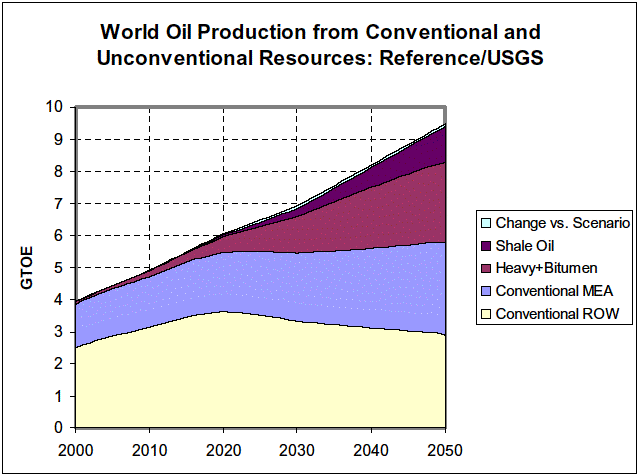
Figure 19
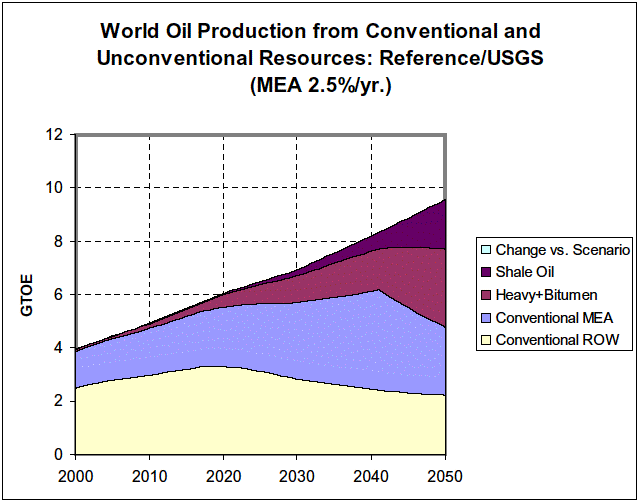
Figure 20

Figure 21
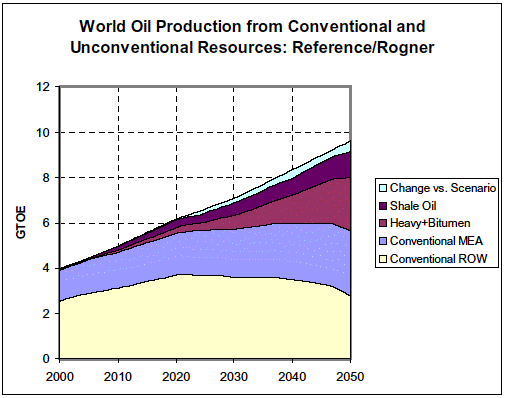
Figure 23
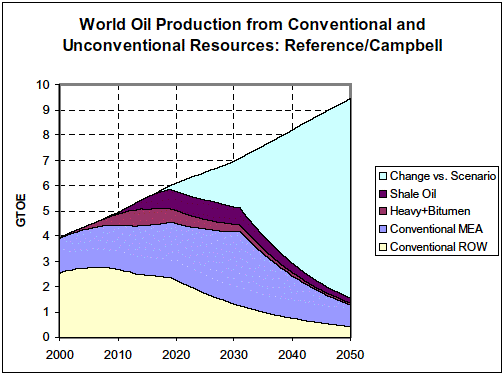
Figure 25
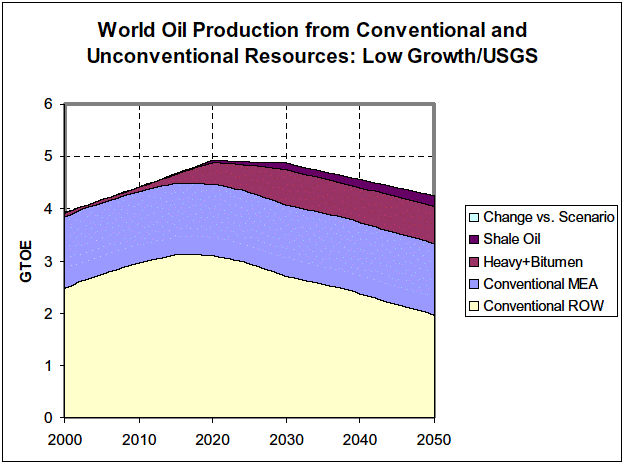
Figure 26
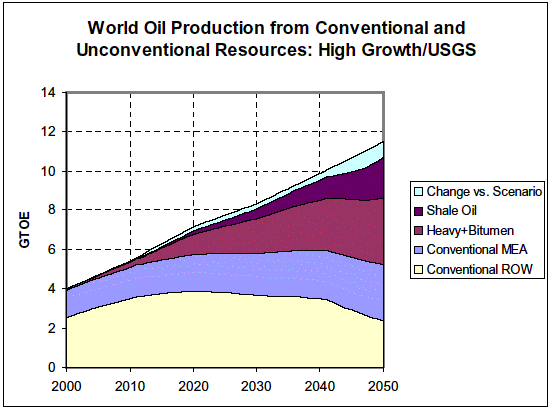
Figure 27
List of figures
List of tables
Acknowledgements
『Abstract
This report presents a risk analysis of world conventional oil
resource production, depletion, expansion, and a possible transition
to unconventional oil resources such as oil sands, heavy oil and
shale oil over the period 2000 to 2050. Risk analysis uses Monte
Carlo simulation methods to produce a probability distribution
of outcomes rather than a single value. Probability distributions
are produced for the year in which conventional oil production
peaks for the world as a whole and the year of peak production
from regions outside the Middle East. Recent estimates of world
oil resources by the United States Geological Survey (USGS), the
International Institute of Applied Systems Analysis (IIASA), the
World Energy Council (WEC) and Dr. C. Campbell provide alternative
views of the extent of ultimate world oil resources. A model of
oil resource depletion and expansion for twelve world regions
is combined with a market equilibrium model of conventional and
unconventional oil supply and demand to create a World Energy
Scenarios Model (WESM). the model does not make use of Hubbert
curves nut instead relies on target reserve-to-production ratios
to determine when regional output will begin to decline. The authors
believe that their analysis has a bias toward optimism about oil
resource availability because it does not attempt to incorporate
political or environmental constraints on production, nor does
it explicitly include geologic constraints on production rates.
Global energy scenarios created by IIASA and WEC provide the context
for the risk analysis. Key variables such as the quantity of undiscovered
oil and rates of technological progress are treated as probability
distributions, rather than constants. Analyses based on the USGS
and IIASA resource assessments indicate that conventional oil
production outside the Middle East is likely to peak sometimes
between 2010 and 2030. The most important determinants of the
date are the quantity of undiscovered oil, the rate at which unconventional
oil production can be expanded, and the rate of growth of reserves
and enhanced recovery. Analysis based on data produced by Campbell
indicates that the peak of non-Middle East production will occur
before 2010. For total world conventional oil production, the
results indicate a peak somewhere between 2020 and 2050. Key determinants
of the peak in world oil production are the rate at which the
Middle East region expands its output and the minimum reserves-to-production
ratios producers will tolerate. Once world conventional oil production
peaks, first oil sands and heavy oil from Canada, Venezuela and
Russia, and later some other source such as shale oil from the
United States must expand if total world oil consumption is to
continue to increase. Alternative sources of liquid hydrocarbon
fuels, such as coal or natural gas are also possible resources
but not considered in this analysis nor is the possibility of
transition to a hydrogen economy. These limitations were adopted
to simplify the transition analysis. Inspection of the paths of
conventional oil production indicates that even if world oil production
does not peak before 2020, output of conventional oil is likely
to increase at a substantially slower rate after that date. The
implication is that there will have to be increased production
of unconventional oil after that date if world petroleum consumption
is to grow.』
1. Introduction
2. World oil resource estimates
2.1. What is oil?
2.2. Are oil resources increasing?
2.3. How much unconventional oil is there?
2.3.1. Heavy oil and bitumen (tar or oil sands)
2.3.2. Shale oil
2.4. The pessimistic viewpoint
2.5. Resource estimates used in this study
3. Modeling oil depletion
3.1. Resource accounting
3.1.1. Accounting for conventional oil depletion
3.1.2. The transition to unconventional oil
3.2. World oil market model: long-run dynamics
3.2.1. Simulating a transition to unconventional oil
4. Scenarios of world energy supply and demand
4.1. Descriptions of scenarios
4.2. Risk analyses and key parameters
4.2.1. Growth rate of Middle East production
4.2.2. Technological change affecting cost
4.2.3. Base year production costs of conventional and unconventional
oil
4.2.4. Reserve growth rates
4.2.5. Speculative resource availability
4.2.6. Target reserves-to-production (R/P) ratio
4.2.7. Conversion of unconventional resources to reserves
4.2.8. Supply and demand parameters
5. Results
5.1. Peaking of conventional oil production
5.2. Sensitivities of peaking dates to key parameters
5.2.1. Low growth scenario
5.2.2. High growth scenario
5.3. Transitions to unconventional oil
5.3.1. The reference scenario at median parameter values
5.3.2. Low and high energy growth scenarios
5.3.3. Potential implications for OPEC's market share
5.3.4. Where might the unconventional oil come from?
6. Conclusions
Is the peaking of conventional oil production imminent?
Will the transition be rapid or slow?
Will a transition to unconventional oil weaken OPEC's market
power?
Areas for future Research
References
Appendix A Description of WESM model
A1. Overview
A1.1 Purpose
A1.2 Function
A1.3 Structure
A1.4 Implementation
A2. Scenario generator
A3. Resource accounting
A3.1 Resource categories
A3.2 Resource stocks and flows
Category I, Proved reserves
Category III, Additional speculative resources
Category IV, Enhanced recovery/reserves growth
Categories V and VI, Unconventional recoverable reserves and
resources
A3.3 Depletion-based production cost estimation
Long-run costs of producing conventional and unconventional
oil
A4. Oil market module
Simulating a transition to unconventional oil
A5. North American/conversion module
A5.1 Reconciling world energy scenario to Champagne Model results
A5.2 International energy outlook - WESM calibration
A5.2.1 Matching regions and energy types
A5.2.2 Inferring final energy and production data from primary
energy
A5.2.3 Splined forecasts
A6. Procedure for executing a model run
A6.1 Selecting a WEC-IIASA scenario
A6.2 Modifying a scenario
A6.3 Inputting Champagne Model cases
A6.4 Calibrating a scenario to create a case
A6.5 Generating an output report
A7. Conclusions
Appendix B. Oil resource estimates based on Campbell
B1. Regular oil reserves (Category I)
B2. Regular oil “yet to find/new fields” and non-regular oil
(Category II)
B3. “Non-regular” oil
B4. Heavy oil (Category V & VI)
B5. Conversion factors
Appendix C. Allocation of USGS based unconventional resource estimates
to Categories V and VI
 Figure 19  Figure 20  Figure 21  Figure 23  Figure 25  Figure 26  Figure 27 |